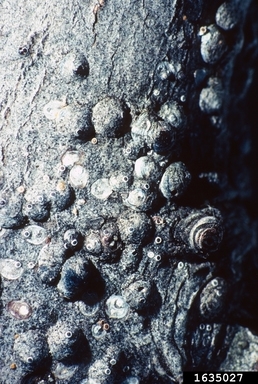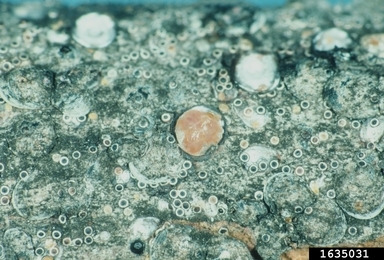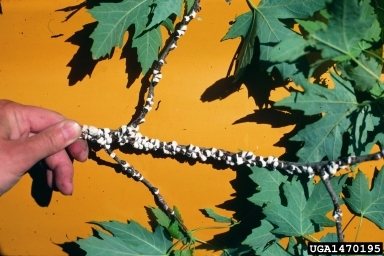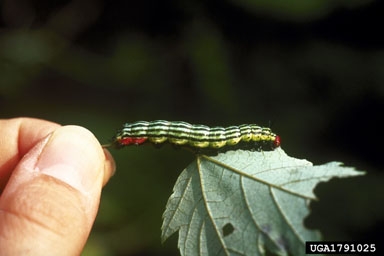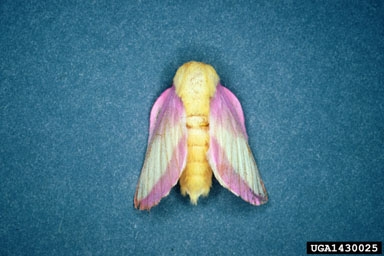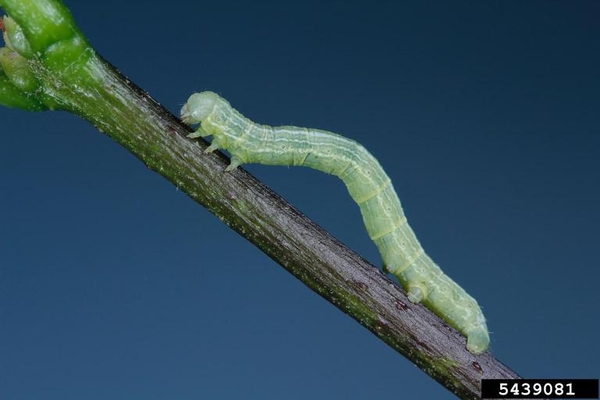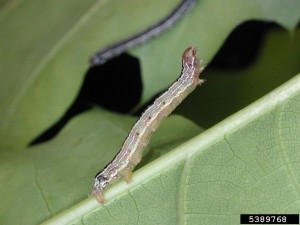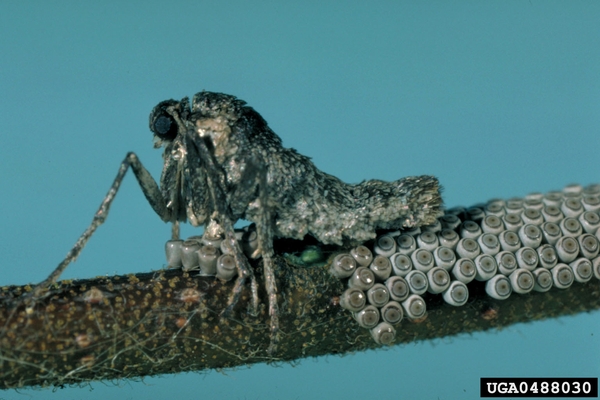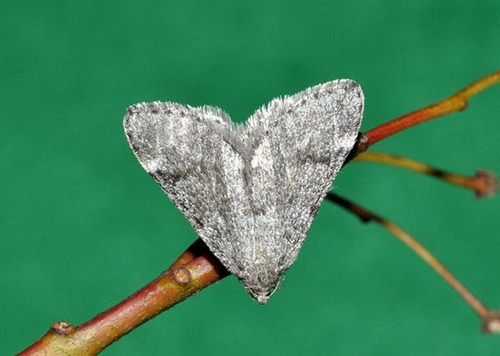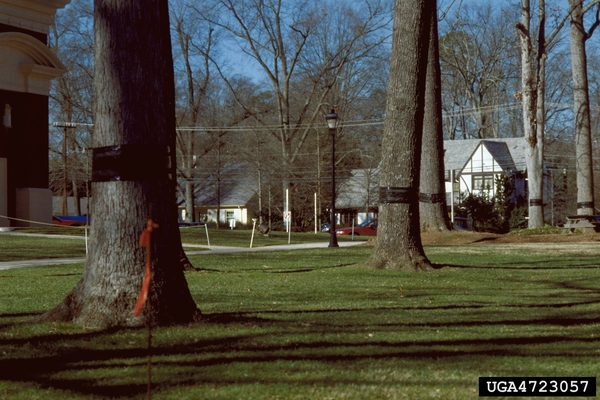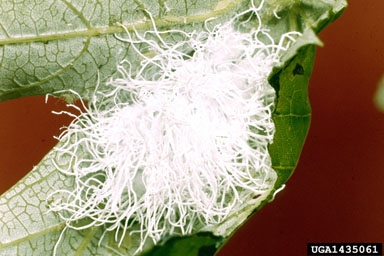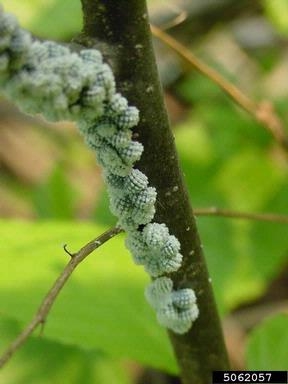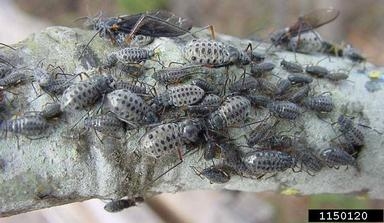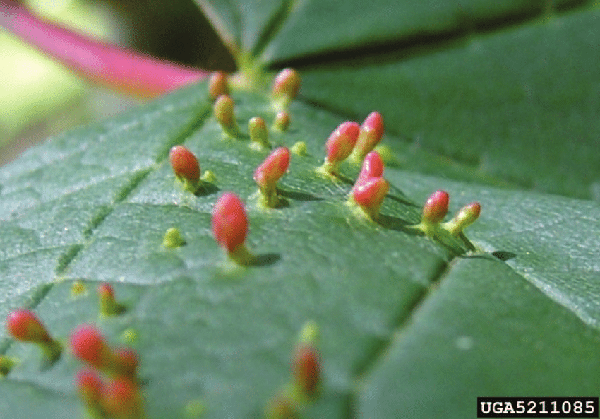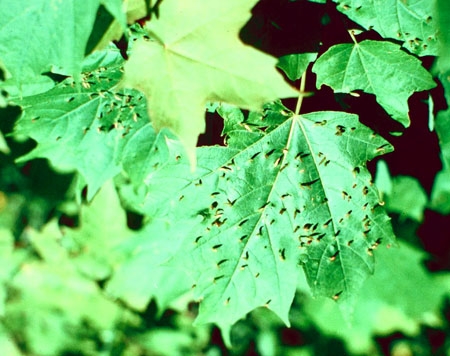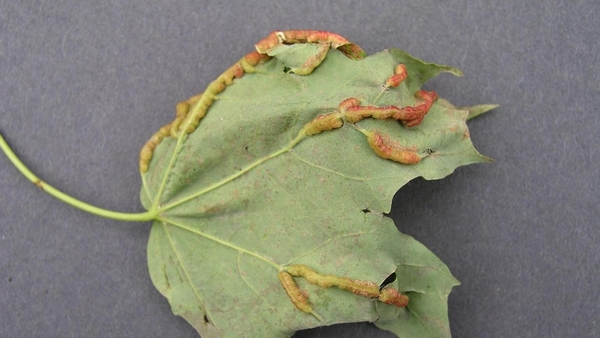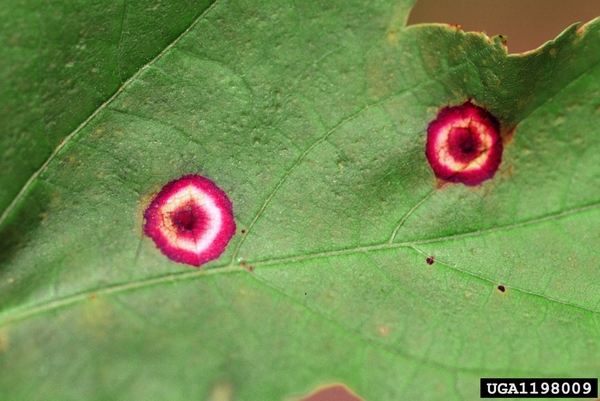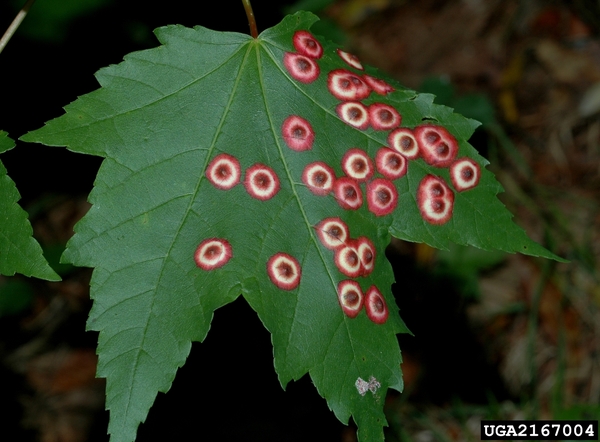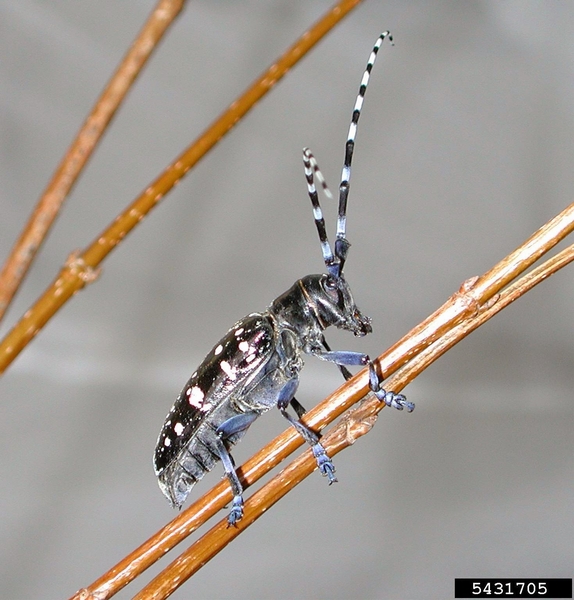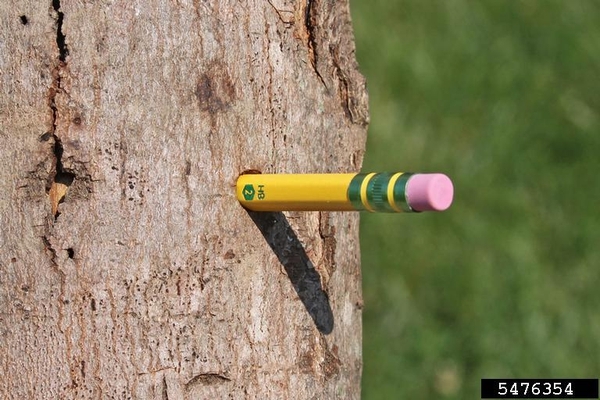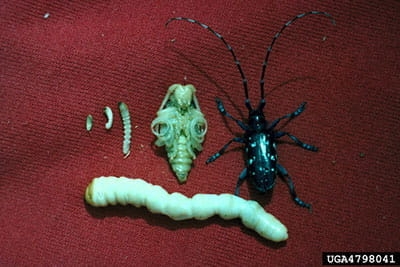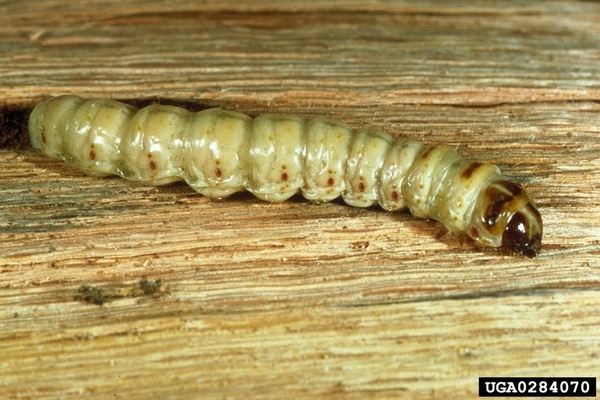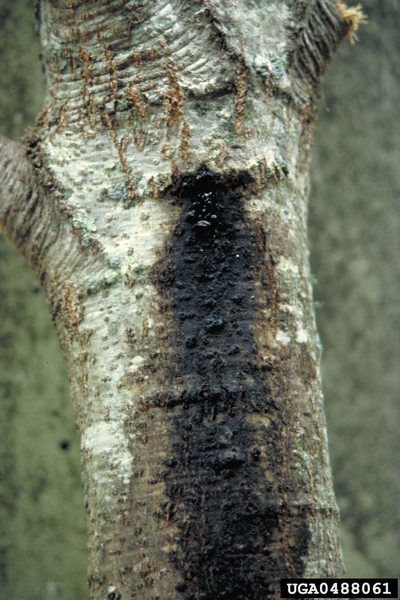SCALE INSECTS
Scale insects are small insects that attach themslees to plants while feeding. They are covered with a shield-like (armored scales) or waxy (soft scales) covering. They damage trees by sucking plant plant fluids through piercing-sucking mouthparts, which reduces general tree vigor, weakening them and/or making susceptible to other agents. Soft scales also excrete honeydew, a sweet, sticky substance which falls on surfaces below them. Honeydew can attract stinging insects and facilitate sooty mold growth. Scale insects are incredibly diverse; therefore, their range of damage can vary from species to species.
Gloomy Scale
Gloomy scale (Melanaspis tenebricosa) is a pest of soft maples, especially red and silver maples, but it can also impact other maples, such as boxelder and sugar maple. The insects use their piercing mouthparts to feed on storage cells under the tree bark, which can cause stunted growth, twig dieback, and thinning in large infestations. The trees might also experience damage from scale saliva inserted during feeding. These scale insects are armored, meaning they have a shield-like cover over them which can be separated from their bodies. The cover is ~2mm wide and tends to blend in with the bark. Underneath this covering, the individual insect is pale pink and circular in shape. In large infestations, the scales give the tree a bumpy appearance due to the crowding of insects on the bark. Management strategies include cultural controls such as choosing proper planting sites and reducing tree stress. Chemical or biological control may be recommended for large infestations. More information about gloomy scale can be found from NC State Cooperative Extension.
Cottony Maple Scale
Cottony maple scale (Pulvinaria innumerabilis) is a pest of silver and red maple trees during the summer. The name ‘cottony’ refers to a secretion produced by the mature female insects. This secretion cover the ovisac, which contains eggs. These eggs hatch in July or August, and the next life cycle of scale immatures, or crawlers, begins. Cottony maple scale crawlers are flat and oval in shape when they first hatch, and the males and females turn different colors with age. The male crawlers are white to pink in color, while the females are tan and slightly larger than males. They feed primarily along major leaf veins, leading to honeydew production and sooty mold, stunted tree growth, and branch dieback. Management strategies may include introducing predators, improving cultural conditions, and standard insecticides. More information about cottony maple scale is available from Ohio State University Extension.
Calico Scale
Calico scale (Eulecanium cerasorum) is a pest of a wide variety of trees, including maple, oak, dogwood, elm, magnolia, and redbud. Like other scale insects, calico scales extract sap from within the tree using piercing-sucking mouthparts. Honeydew excretion can attract ants and other insects or facilitate the growth of sooty mold. Heavy infestations may result in leaf drop, growth stunting, dieback, and perhaps death of the tree. The female insect has a calico black and white pattern on its covering, but can turn brown with age. The newly-hatched immature insects are light pink and eventually turn yellow. In late spring and early summer, the immatures can be found on the underside of leaves. Management strategies primarily include cultural control and reducing tree stress. More information about calico scale is available from NC State Extension.
FOLIAGE-FEEDING INSECTS
Leaf-eaters and defoliators are usually caterpillars or other larval insects. They are capable of skeletonizing leaves or defoliating trees, either partially or wholly. This can cause damage if done in large amounts or consecutively year-after-year.
Greenstriped Mapleworm
The greenstriped mapleworm (Dryocampa rubicunda) is a defoliator of maples and sometimes oaks in close proximity to maples. They feed in early summer, from May to June in North Carolina. Each mapleworm is capable of consuming several leaves, resulting in major defoliation when infestations are large. Consecutive defoliation events year after year can result in stunted growth and dieback. The greenstriped mapleworm has a bright red to black head and a yellow-green body with seven green stripes that run from the head to the abdomen. They have black spikes on each side of their bodies, and two horn-like projections on the second thoracic segment. In late spring, the adult moth will emerge from its pupa. The moth, also known as the rosy maple moth, is yellow with pink and yellow wings. They will lay yellow eggs on leaf undersides, prompting the next generation to grow. Management strategies may include cultural control or narrow-spectrum pesticides. More information about the greenstriped mapleworm is available from NC State Extension.
Cankerworms
Spring cankerworms (Paleacrita vernata) and fall cankerworms (Alsophila pometaria) are abundant defoliators of many species of hardwood trees, including maple, oak, beech, elm, ash, dogwood, and cherry. The female insects emerge in the spring (spring cankerworm) or fall (fall cankerworm) and lay eggs on the twigs in clusters. In the spring, the eggs of both species hatch and young caterpillars skeletonize the leaves, often leaving only the midrib. The caterpillars are sometimes called “inchworms” since they have a gap between their two sets of legs that gives them the appearance of “inching” as they crawl. Depending on the age of the caterpillar, they can be green with pale stripes or green with dark stripes. Adult moths are gray. Females are flightless and must crawl up the tree truck to lay eggs, a behavior that is taken advantage of for management purposes. Management strategies may include banding the trees with sticky material to intercept female trunk ascension and applications of pesticides. In severe infestations, municipalities may spray large areas. More information about spring cankerworms and fall cankerworms is available from NC State Extension.
APHIDS
Aphids are soft-bodied insects that feed on plant fluids with piercing-sucking mouthparts. They can be found on bark or leaves and often occur in colonies. They do not usually cause serious damage, but can cause leaf distortion or aesthetic damage from sooty mold growth.
Woolly Alder Aphids
Woolly alder aphids (Prociphilus tessellatus), also known as maple blight aphids, are pests of primarily silver maple, but are occasionally observed on red maple. They require both alder and silver maple to progress through their life cycle. The “woolly” in their name refers to the white fluffy secretion the aphids produce. The immature aphids are wingless and produce strands of white 'wool' and feed on the sap of maple trees through the summer. The honeydew produced by the aphids attract bees, wasps, and flies and can facilitate the growth of sooty mold. In early summer, the final generation of aphids develop wings and fly to alder trees. In the fall, the final alder generation migrates back to maple trees and mate. Though the presence of this insect can be unsightly and alarming, they usually do not cause significant damage, and control is expensive. More information about the woolly alder aphid is available from NC State Extension.
Giant Bark Aphids
Giant bark aphids (Longistigma caryae) are the largest species of aphid present in North Carolina, measuring at about ¼ inch. They are common on the bark of several deciduous trees, including elm, maple, oak, birch, walnut, and willow. The wingless aphids are gray and have four rows of dark spots on their backs. Some of the young aphids will develop clear-gray membranous wings. The feeding from these aphids, combined with sooty mold growing upon honeydew, can cause stunted growth and dieback in severe infestations. More information about giant bark aphids is available from NC State Extension.
GALLS
Galls are unusual outgrowths of plant tissue caused by insects, mites, fungi, or other organisms. They do not often cause serious damage to their host plants, but can be aesthetically dipleaseing and occasionally are managed.
Maple Bladder Galls (Caused by Maple Bladder-gall Mite)
Maple bladder galls (Vasates quadripedes) are most common on red and silver maples and caused by a small eriophyid mite (non-insect). The galls are prominent, round, wart-like structures on the upper side of the leaves. At the beginning of the infestation, the galls are yellowish-green in color, but later progress to red and then black. Though unsightly, this gall does not typically cause severe damage to the tree. Chemical applications may serve to prevent new galls from forming. More information about maple bladder galls is available from NC State Extension.
Maple Spindle Gall (Caused by Maple Spindlegall Mite)
Maple spindle galls (Vasates aceriscrumena) are pests of sugar maple and are caused by an eriophyid mite (non-insect). The galls are green, spindle-shaped, and lie on top of the leaf surface. They may appear to be pointing upwards away from the leaf surface. Since this gall rarely causes damage to the tree, treatment and management are not typically recommended. More information about maple spindle galls is available from NC State Extension.
Gouty Vein Gall (Caused by Gouty Vein Midge)
Gouty vein midges (Dasineura communis) are pests of sugar maple. The damage on the tree is caused by a gnat-like midge. The galls themselves are yellow in color and spread directly along leaf veins. In large infestations, the galls can crumple the leaf, which often looks like herbicide damage. Though the crumpling and aesthetic damage can be alarming and look serious, these galls rarely cause threatening damage to trees. More information about gouty vein gall midges is available from NC State Extension.
Maple Eyespot Gall (Caused by the Ocellate Gall Midge)
Maple eyespot galls are bright red and yellow bullseye-shaped spot and impact red maple. They are caused by a small fly, the ocellate gall midge (Acericecis ocellaris). The spot is a result of female egg-laying on the underside of leaves, causing a chemical response leading to the formation of this colorful gall. Maple eyespot gall is rarely damaging to trees. More information about maple eyespot gall is available from NC State extension.
WOOD-BORING INSECTS
Wood-boring insects spend part of their life cycle within a tree. Because of this, they cause internal damage and can be difficult to detect. Thus, it is important to be able to identify non-borer life stages or characteristic symptoms of borer insects.
Asian Longhorned Beetle
The Asian longhorned beetle (ALB; Anoplophora glabripennis) is an invasive insect pest that devastates a variety of tree species, including maples, birch, poplar, ash, and other hardwoods. Of its host, it greatly prefers red maple. This insect was first detected in the United States in 1996, and has since been found in five states: Illinois, New Jersey, Massachusetts, Ohio, and South Carolina. This invasive beetle has yet to be detectied in North Carolina, but it was detected in South Carolina in 2020. The most damaging stage of ALB is the larvae, which bore into the tree and feed in the inner bark and outer wood. This causes branch dieback and breakage, wilting and yellowing of leaves, and death after several years. The larvae progress into the heartwood and inner xylem as they age, and emerge as adults a few weeks later. The emerging adults create round exit holes that are a key identifying characteristic of ALB. There is no cure once the insect infests the tree. North Carolinians who suspect ALB should report it to the North Carolina Department of Agriculture and Consumer Services’ Plant Industry Division. More information about ALB identification and control can be found from NC State Extension.
Carpenterworm
Carpenterworms (Prionoxystus robiniae) are moth larvae that infest shade trees such as oak, maple, ash, elm, willow, and poplar. They bore into the heartwood of the main trunk and individual branches, which may cause branches to break off in severe infestations. They rarely kill trees, but are capable of damaging lumber and reducing the value of commercial trees. Since the generations of this insect overlap in North Carolina, both larvae and adult moths can be found at any time throughout the growing season every year. Removing heavily infested trees and branches and probing larval tunnels with wires are methods of control that have been utilized, but there is no universally accepted method of control in the forest. More information about carpenterworms is available from NC State Extension.
Publication date: April 21, 2022
N.C. Cooperative Extension prohibits discrimination and harassment regardless of age, color, disability, family and marital status, gender identity, national origin, political beliefs, race, religion, sex (including pregnancy), sexual orientation and veteran status.

